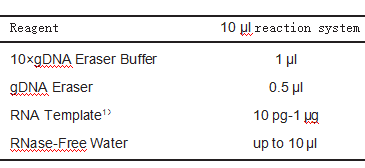Determine the necessary mass, volume, or concentration for preparing a solution.
Basic Description
| Storage Temp | Store at -20°C,Avoid repeated freezing and thawing | |||||||||||||||||||||||||||||||
|---|---|---|---|---|---|---|---|---|---|---|---|---|---|---|---|---|---|---|---|---|---|---|---|---|---|---|---|---|---|---|---|---|
| Shipped In | Ice chest + Ice pads | |||||||||||||||||||||||||||||||
| Product Description |
Product Introduction This product is a kit for removing genomic DNA for reverse transcription. The kit removes genomic DNA in 2 minutes at 42°C. Since the reverse transcription reagent contains a component that inhibits gDNA Eraser, cDNA can be synthesized directly by reverse transcription of gDNA Eraser-treated samples.The kit is equipped with a new high-efficiency reverse transcription enzyme, HiFiScript, with novel mutation sites that dramatically increase the transcriptional activity of the enzyme, resulting in higher efficiency and yield of cDNA first-strand synthesis. The first strand of cDNA can be synthesized with higher efficiency and yield, and the first strand of cDNA can be synthesized from pg total RNA or mRNA. If the reverse transcription product cDNA is used for downstream fluorescence quantitative detection, the reverse transcription reaction can be completed at 42℃ in 15 minutes. This kit is suitable for the synthesis of first-strand cDNA and subsequent RT-PCR, RT-qPCR, and the construction of full-length cDNA libraries. Product Features 1. Rapid genome removal: contains gDNA Eraser for genomic DNA removal, which removes genomic DNA in just 2 minutes. 2. Rapid reverse transcription: 15 minutes to obtain fluorescent quantitative PCR template cDNA first strand synthesis. 3. High sensitivity: cDNA first strand can be synthesized using pg-level total RNA or mRNA templates. 4. Highly efficient reverse transcription: Novel mutation sites dramatically increase enzyme activity, resulting in higher yields of cDNA. matters needing attention 1. During operation, RNase contamination should be avoided to prevent RNA degradation or cross-contamination in the experiment. It is recommended that operators wear masks and disposable gloves and change the gloves frequently, and use specialized instruments and consumables. 2. The reverse transcription system is prepared and operated on ice to prevent degradation of RNA. Store the kit enzymes at -20ºC as soon as possible after use and try to avoid repeated freezing and thawing. 3. The reaction system can be scaled up to a maximum of 1 μg of total RNA in 10 μl of reaction system. 4. Primer Mix is prepared by Oligo(dT) and Random primer, and Oligo-dT Primer or Gene Specific Primer can also be used according to the experimental needs. 5. If the amount of starting RNA is less than 50ng, it is recommended to add RNAase inhibitor (RNasin). 6. For RNA templates with complex secondary structures, it is recommended to incubate the template RNA at 65°C for 5 minutes immediately on ice prior to the manipulation step and centrifuge briefly before proceeding to the next step. Usage Thaw template RNA on ice; place kit components on ice immediately after thawing at room temperature. Each solution was mixed by vortexing and shaking before use and briefly centrifuged. I. Genomic DNA removal reactions 1. Prepare the reaction system according to the following table on ice in a total volume of 10 μl. To ensure the accuracy of the reaction solution preparation, prepare the premixed system in the amount of reaction number + 2 before dispensing it into each reaction tube and finally adding the RNA sample.
Note: 1) If the amount of total RNA is greater than 1µg, scale up the reaction system proportionally. If the amount of starting RNA is less than 50ng, it is recommended to add RNAase inhibitor (RNasin). 2. Mix by vortex shaking and centrifuge briefly so that the solution on the walls of the tube collects at the bottom. 3. Incubate at 42°C for 2 minutes (this can be extended to 30 minutes for room temperature reactions). 4.At the end of the reaction, centrifuge briefly and place on ice to cool. II. Reverse transcription reaction 1. Prepare the reaction system on ice according to the following table. In order to ensure the accuracy of the reaction solution configuration, first prepare a premixed solution in the amount of number + 2, and then dispense 10 μl into each reaction tube, take 10 μl of the prepared premixed solution and add it to the reaction tube of step 1 where the de-etching of the genome has been completed.
Note: 1) Oligo-dT Primer or Gene Specific Primer can be used according to the needs of the experiment, it is recommended to use 50 pmol of Oligo-dT Primer or 2 pmol of Gene Specific Primer for 20 μl reaction system. 2. Mix well and centrifuge briefly so that the solution on the walls of the tube collects at the bottom. 3. cDNA synthesis reaction conditions: 1) If fluorescent quantitative PCR assay is performed downstream, incubate at 42°C for 15 minutes and 85°C for 5 minutes. 2) If downstream for normal PCR assay, incubate at 42°C for 30-50 minutes and 85°C for 5 minutes. Note: For templates with complex secondary structure or high GC content, the reverse transcription temperature can be increased to 50°C to enhance reverse transcription efficiency. 4. At the end of the reaction, centrifuge briefly and place on ice before proceeding with subsequent PCR or fluorescence quantitative PCR, or place at -20°C if prolonged storage is required. Note: When performing Real-time PCR reactions, the amount of reverse transcription product added should not exceed 1/10 of the total volume of the PCR reaction. |
Certificates
Certificate of Analysis(COA)
Enter Lot Number to search for COA:



